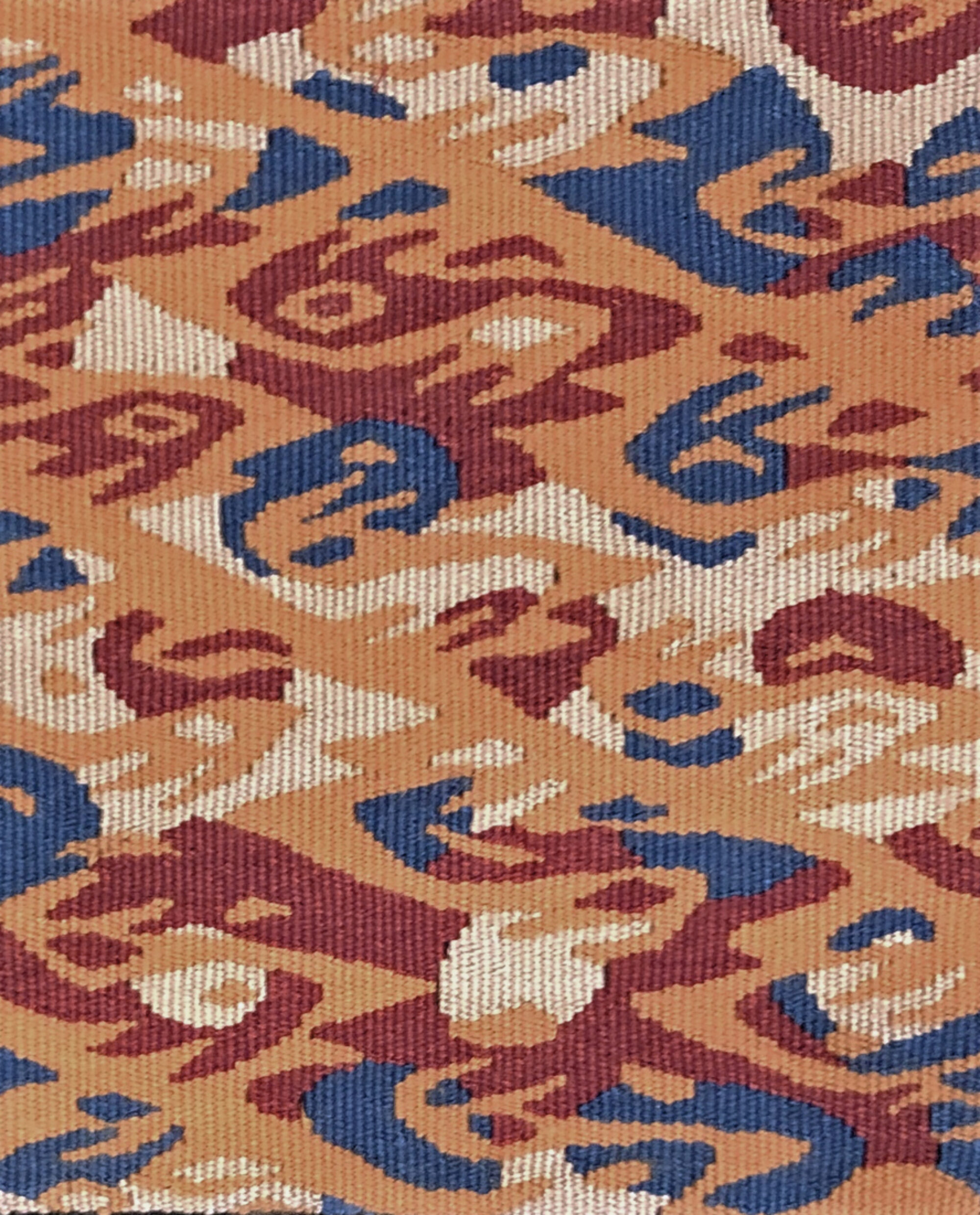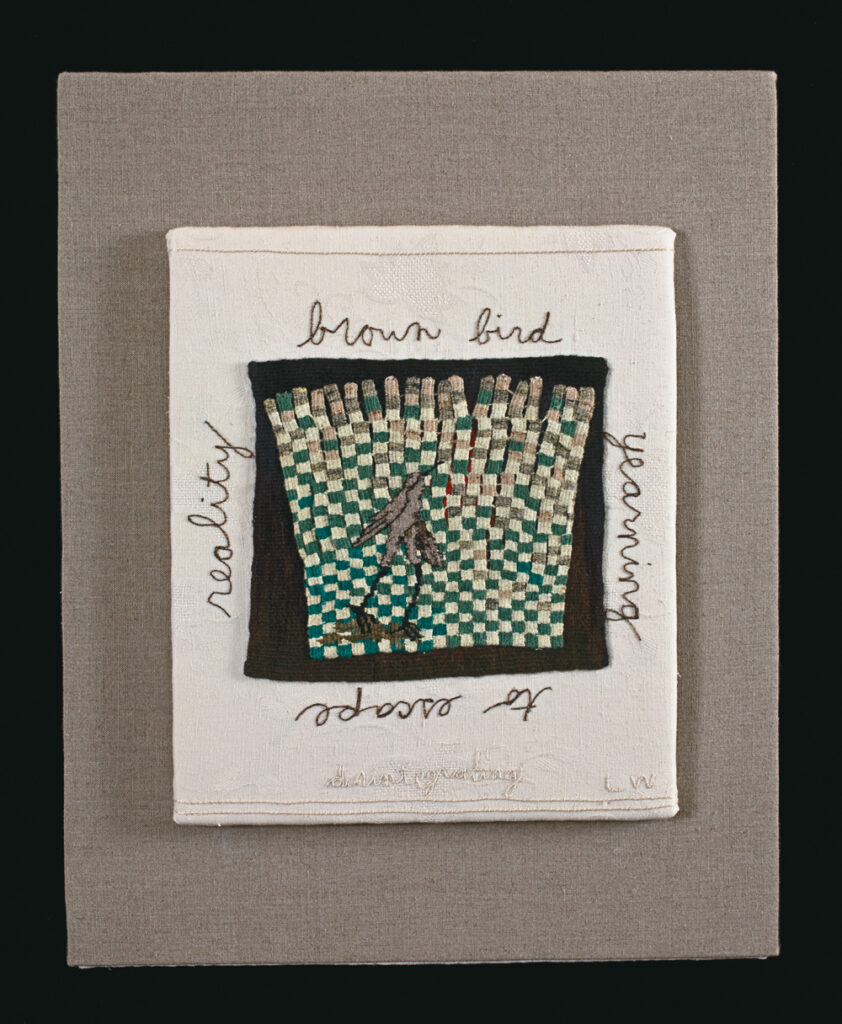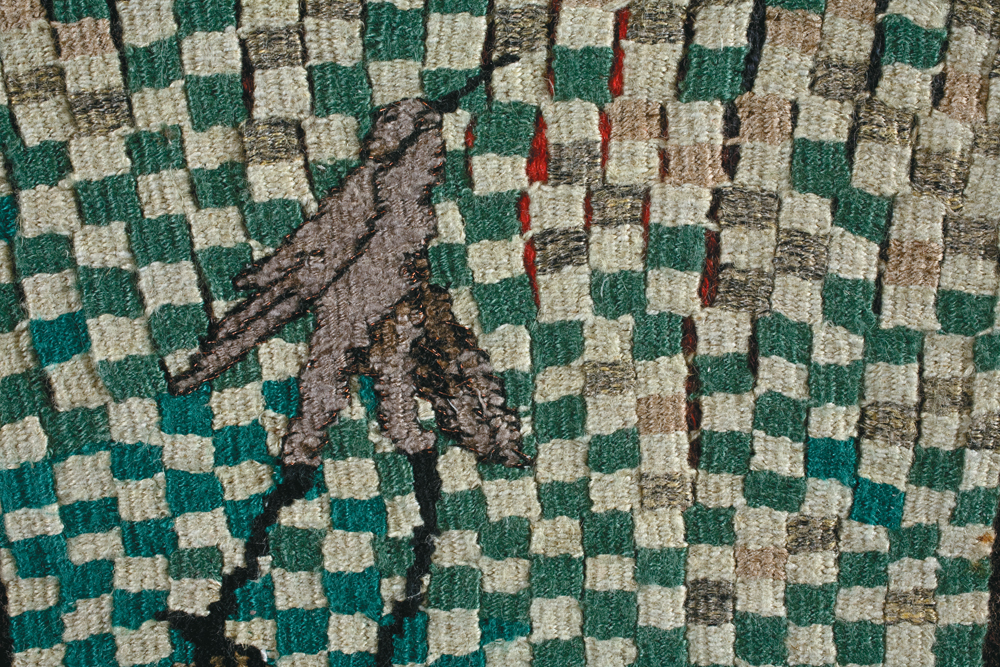This exhibition review was first published in Textile Fiber Forum, Vol. 29,Issue 4, 2010.
Dialogues: Tapestry and Human/Nature
Albuquerque, NM, 2010
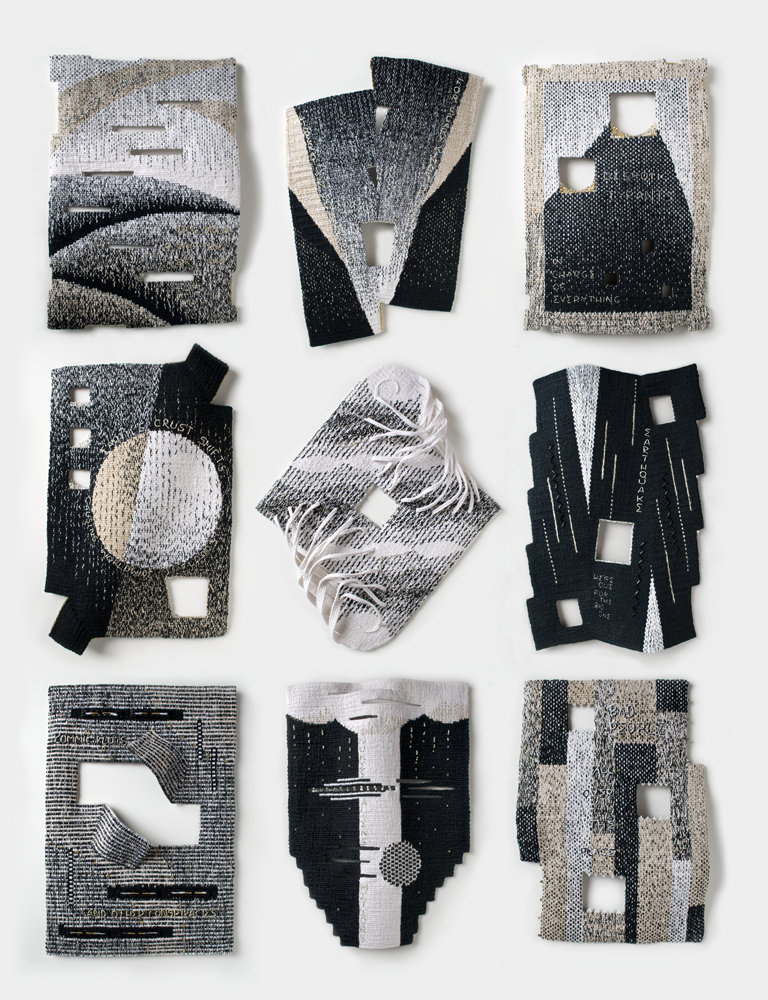
Lan Eila, Any Time Now: One Family’s Soft-book Primer of Anticipated Catastrophes,” 43″ x 32″ x 2″
Dialogues: Tapestry and Human/Nature opened on July 5, 2010 in Albuquerque, New Mexico, USA. Mounted in conjunction with the Handweavers Guild of America’s biennial conference, the exhibition featured the work of one Australian, Dorothy Clews, two Canadians, Elaine Duncan and Linda Wallace, and three Americans, Elizabeth Buckley, Lany Eila and Kathy Perkins. The six artists, collectively known as Tapestry 3-2-1, published the following statement in conjunction with Dialogues:
“This exhibit uses hand woven tapestry as both medium and metaphor to explore the complex boundaries between humans, nature, and human nature. The inherent fragility of the plant and animal fibers used in the creation of these works can serve as a potent metaphor for the fragility of human life and ecosystems. The tapestry medium offers a deep historical resonance as well as an opportunity for contemporary explorations in structure and material.”
The work exhibited in Dialogues speaks to the breadth and depth of expression found within the field of contemporary tapestry. The tapestries include intimate glimpses of nature, three-dimensional abstractions rendered entirely in black and white and conceptual multimedia explorations.
Two of the artists, Dorothy Clews and Linda Wallace, have been involved, for a number of years, in parallel investigations of the aesthetic potential of partially decomposed cloth. Working across the globe, and in radically different environments, each artist has woven tapestries and then buried them, or from a more generative point of view, planted them. After varying amounts of time, they then reclaim the tapestries by exhuming, or, harvesting, them. Through subsequent conservation and creative exploration, the artists transform the unraveling cloth into delicate statements on both fragility and resilience.
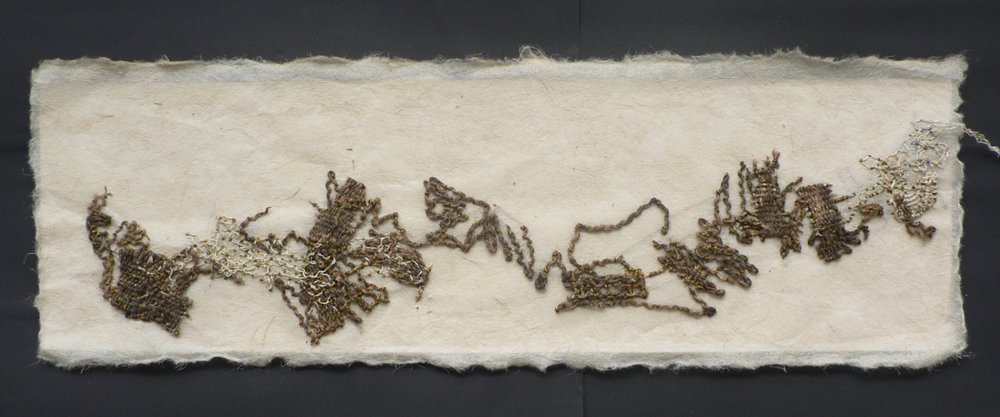
Clews’ multimedia work, Pulse Panel, consists of several pieces of handmade paper onto which the artist has carefully stitched a partially decomposed tapestry. The entire assemblage stretches horizontally across the wall. The accumulation of hundreds of tiny, meticulous stitches offers a visual record of the labor and time involved in art making. The elongated format of Pulse Panel suggests the narrow draw in which Clews buries her work. It also brings to mind landscape, which is both a subject of the artist’s work and an active partner in her art making process. Clews refers to the entire series as “Field Trials,” a reference to the tests that seeds undergo in their commercial development. In a manner similar to farmers, Clews tests the susceptibility of the different threads in her tapestries to decomposition.
Despite Clews’ multimedia approach to her work, she sees it, fundamentally, as tapestry. “I am acknowledging a premise that ‘tapestry-ness’ remains in the nature of the decomposed fabric like DNA…” Her willingness to explore the edges of her medium through a collaboration with nature speaks to an inquisitive mind and an openness to heretofore, unknown possibilities.
In addition to her work with buried tapestries, Linda Wallace also exhibited a group of tapestries using the image of a bird to reflect on psychological and emotional uncertainties. In …frayed…, a long legged bird stands with wings slightly unfolded. Firmly planted on a grid of squares, he gazes upward, perhaps to something, or somewhere, less bound to the static and right-angled world at his feet. And, as if in response to his yearnings, the fabric opens up at the top of the tapestry, the solid woven checkerboard fanning out, through a series of slits in the fabric.

Elaine Duncan’s series entitled “Art in Nature,” is an homage to nature’s skillful design. Wooden frames surround the carefully cropped images, inviting us to look closely, and to contemplate nature’s beauty. The strong light and shadow, and the close cropping in Debris floating on water remind us of the fine line between abstraction and representation.
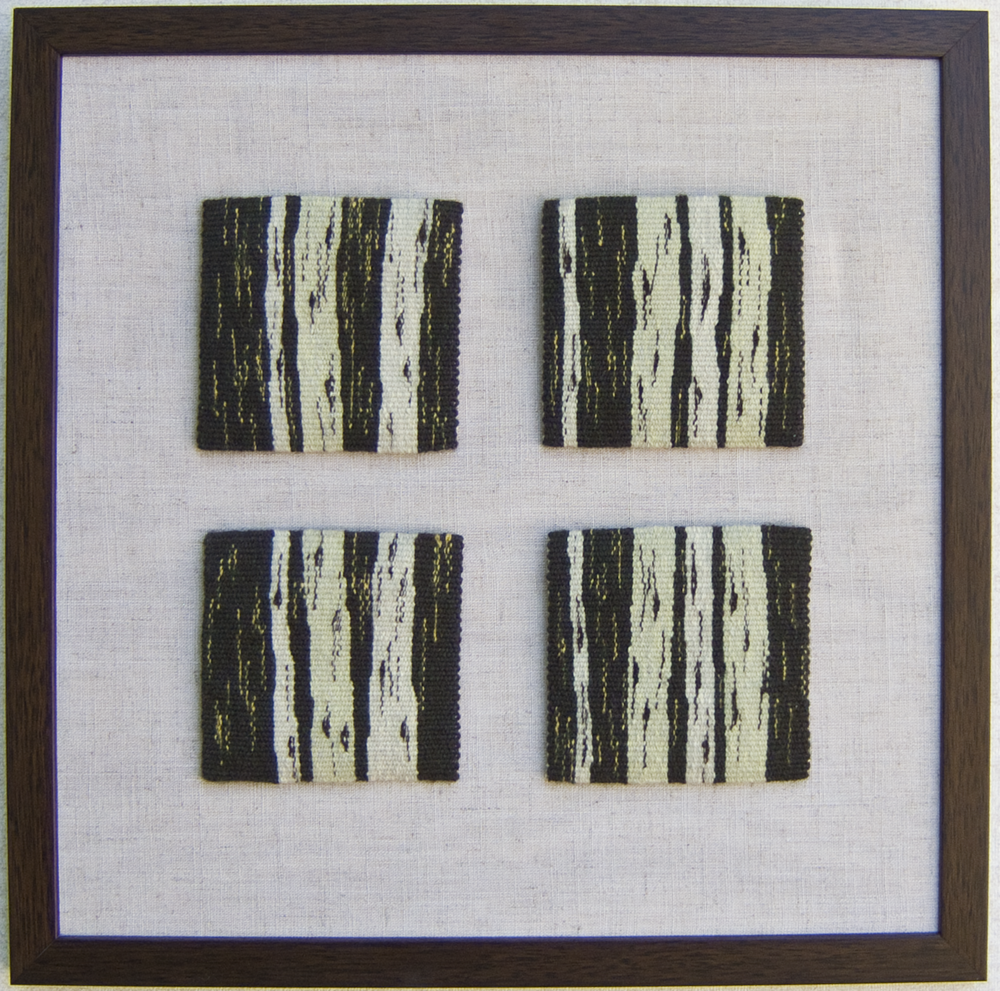
Elizabeth Buckley has also explored the power of nature, closely observed. In Aspen Rain four tapestries depicting cross sections of Aspen trunks are mounted together. The rhythm of dark and light, of foreground and background, shifts subtly from piece to piece, and the mind is left to wander as it explores the pictorial space that fluctuates between flat and recessional.

photo: Lany Eila
Kathy Perkins’ tall, vertical Wild Wood III: Quaking Aspen positions a strong, sinuous and abstracted tree trunk against a vivid blue sky. The curving trunk pushes against the edges of the tapestry, seemingly having outgrown the limits of the cloth since the tapestry was woven. The viewer is situated at the base of the tree, as though (s)he were a small mouse looking upward at this majestic tree through a few large leaves hanging near the forest floor.
In Any Time Now: One Family’s Soft-book Primer of Anticipated Catastrophes Lany Eila has given visual form to the fears promulgated in her family. From Earth’s Crust Shifts Causing Worldwide Floods to Commie Plots and other Conspiracies, each often heard warning is represented in black, white and, perhaps, thankfully, now, gray. The warp and weft of the shaped and twisted tapestries shift, seemingly in response to the power of the catastrophe. The voids in the tapestry suggest the destruction of the anticipated evil, or perhaps a hole in the thinking of those who harbored the fears. This technically skillful and conceptually clever and witty set of tapestries is a delight to ponder.
Dialogues was thoughtfully hung in a brightly lit, public venue. Each artist was represented by a half dozen tapestries, offering those who came to view the exhibit a unique opportunity to explore the artists’ development of themes and techniques. For those who visit the city complex for other reasons, the strength and diversity present in the show will offer a wonderful introduction to contemporary tapestry.
